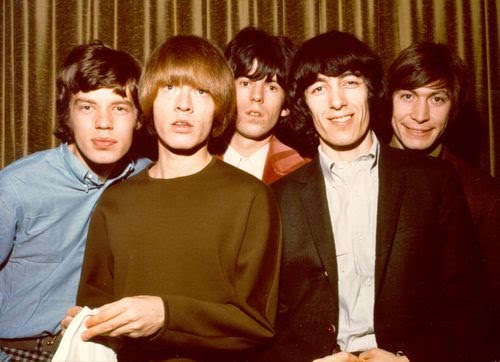The Rolling Stones in The Stones and Brian Jones.Rock ‘n’ roll’s first great drug casualty gets efficiently examined in “The Stones and Brian Jones,” the latest music documentary from Nick Broomfield (“Marianne & Leonard,” “Biggie and Tupac,” “Kurt & Courtney”).
Downbeat as it inevitably is – Rolling Stones founder Jones established the 27 Club when he drowned in his swimming pool in 1969, three weeks after Mick Jagger and Keith Richards kicked him out of the band because he was too stoned even for them. The film is sure to delight nostalgic Boomers and music historians with unseen footage and insights from survivors who were there.
As is Broomfield’s way, emphasis is placed on the tabloid tragedy of Jones’ life than on his artistic accomplishments (when he’s not making music docs, the director gravitates to subjects such as serial killer Aileen Wuornos and Hollywood madame Heidi Fleiss). Kicked out of their proper British home by his parents at 17, the beautiful boy with the perfect blond mop top pioneered the Generation Gap conflicts that would soon flower in the Hippie Era. Blues-loving Jones charmed his way into a series of girlfriends’ family homes, though, leaving at least five of the lasses pregnant before moving on to the next.
“He had the suave,” one still-besotted ex, Dawn Molloy, notes.
Period and contemporary comments from those women plus many who came and went later create a portrait of a sensitive, irresponsible fellow who could indulge a dark, cruel streak. We also hear all four of his bandmates (along with the likes of Paul McCartney and Marianne Faithful) making logical, if superficial, psychological observations over the years. An elderly, energetic Bill Wyman, the bassist who was the main target of Jones’ bullying pranks back in the ‘60s, is delightful in a recent set of interviews, doing air guitar like a boss to demonstrate his colleague’s six-string mastery, and noting how it was Jones who expanded the band’s blues-rock sound with new instruments on such tracks as “Ruby Tuesday” and “Paint It, Black.”
Most fun, of course, is the footage of the Stones’ early heyday. There’s remarkable color coverage of a Swinging London party in which they kiss all the girls, while Jagger’s jealousy of Jones’ superior sex appeal is evident. Television interviews from the mid-‘60s illuminate the group leader power struggle between Mick and Brian, and we learn why Keith kept switching sides. Girl mobs immobilizing London and wrecking the Sydney airport, along with violent stage assaults at Stones club shows, make it clear that Altamont was not an anomaly for the bad boy rockers of the peace-love-and-drugs generation.
Towards the end, Jones was downing speed with scotch-and-cokes six sleepless days a week. He could barely play guitar for his last performance, in “The Rolling Stones Rock and Roll Circus” concert film. His paranoia that Mick and Keith were conspiring to be mean to him was irreversibly reinforced when Jones’ girlfriend at the time, Anita Pallenberg, hooked up with Richards at the Cannes Film Festival. Filmmaker Volker Schlöndorff, who was there with his Pallenberg-starring movie that Jones was too blitzed to compose a decent score for, is still amusingly nonplussed by the emotional insanity of it all.
All told, “The Stones and Brian Jones” recaptures a wild time, the price at least one man paid and some of the collateral damage done in the process. No denying, Brian Jones was a sad figure. But he was also a great one, arguably the architect of rock ‘n’ roll’s ultimate aesthetic expression. Still waiting to see a movie about that.




